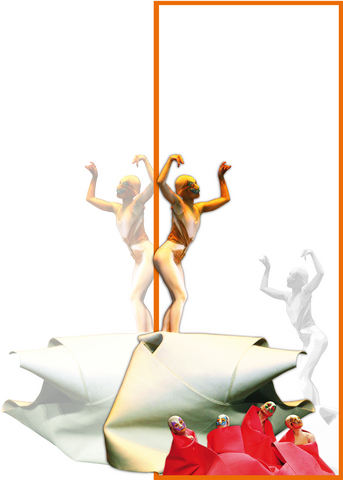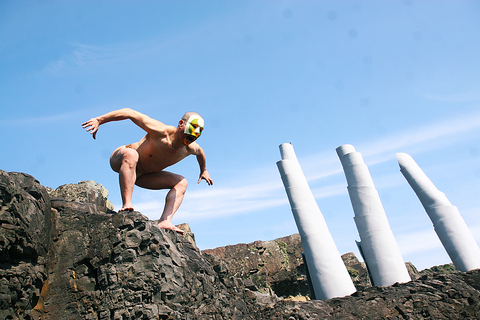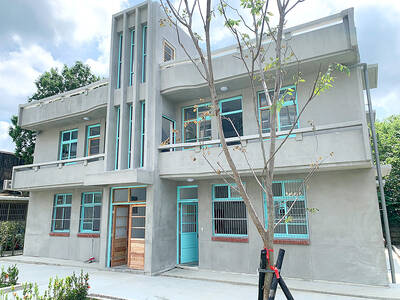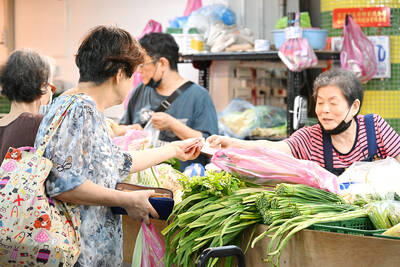Taipei Dance Circle (光環舞集) founder and choreographer Liou Shaw-lu (劉紹爐) usually drenches his dancers in baby oil before setting them loose to glide about the stage. The lack of friction between the dancers' bodies and their surroundings has been an essential component of his work.
This year, in Man and Object, friction is back. Liou wraps his six dancers in what he calls sponges, though to the uninitiated the material looks more like a cross between a big bed sheet and a yoga mat. The dancers roll up, roll out, bend and twist, constrained by their wrappings yet free to create forms, angles and movements that they could not do by bodies alone.
Liou said he was trying to focus on the internal — the spiritual — dimension of dance.

"I have made many oil dances in 13 years. Every time we perform we have a sponge underneath to take care of the dancers. We can feel it like a skin," Liou said yesterday in a telephone interview, explaining how he came up with the idea of using sponge mats for this piece.
"By limiting movement, sometimes it's a struggle like we have in real life ... struggle, but then freedom comes out," he said.
At the beginning of Man and Object the sponge-mats are on the floor and the dancers emerge "like new life coming out of the earth," he said.

PHOTOS: TAIPEI DANCE CIRCLE
"At the end, we are moving on the ceiling," to give the impression of "nature being so big and mankind is so small," he said. "It's very dreamlike — the sponge makes very strange shapes, just like visions."
Liou's wife and artistic partner Yang Wan-jung (楊宛蓉) said the sponges are hard on the dancers.
"They can't see the direction they are going — there's only a small hole to see through — so they have to think they are moving east, west, north," she said.
The lack of a clean count in the score makes things still more difficult for the dancers, as well as Liou's preference for a clean floor, which rules out using tape strips as floor marks. If that wasn't enough of a challenge, the dancers also have to cope with changes in their numbers each night.
Depending on the size of the stage they are using, Liou may have to pull a dancer out of a section if there isn't enough room for everyone to move. "This time the performances are all on big stages — except for Taoyuan and Nantou — so we are lucky," Yang said.
Flexibility is obviously a key requirement for a Taipei Dance Circle dancer, in addition to their basic training in dance and taichi. Liou used the music of modern Japanese composer Keiko Harada as the basis for Man and Object. He met Harada last year when he was invited to perform in Japan. He said he found her music very special, defying easy categorization. Her music is Asian, but largely uses Western instruments.
"The sounds are very original, not a beautiful melody," Liou said.
Harada gave Liou several of her compositions and he brought them back home to listen to before picking out the bits he wanted to use.
The score is performed by seven musicians, but it also incorporates chanting by the dancers.
"We have had eight years of body and voice coordination ... . Chinese movement comes from the dantian (丹田); so does the dancers' music and voices. So some sections have both music and voice, some have just voice, some just music," Liou said.
Harada and her parents came from Japan for the company's opening night in Taichung on March 31. Yang said that Harada was surprised by the way Liou had used her music but was very happy with the result. While the company has just four more performances ahead of them after tomorrow nights' show in Sinjhuang, Liou and Harada are hoping to find the funding that will allow the company to take Man and Object to Japan at some point, and for Harada to perform her music live with the company.

June 2 to June 8 Taiwan’s woodcutters believe that if they see even one speck of red in their cooked rice, no matter how small, an accident is going to happen. Peng Chin-tian (彭錦田) swears that this has proven to be true at every stop during his decades-long career in the logging industry. Along with mining, timber harvesting was once considered the most dangerous profession in Taiwan. Not only were mishaps common during all stages of processing, it was difficult to transport the injured to get medical treatment. Many died during the arduous journey. Peng recounts some of his accidents in

“Why does Taiwan identity decline?”a group of researchers lead by University of Nevada political scientist Austin Wang (王宏恩) asked in a recent paper. After all, it is not difficult to explain the rise in Taiwanese identity after the early 1990s. But no model predicted its decline during the 2016-2018 period, they say. After testing various alternative explanations, Wang et al argue that the fall-off in Taiwanese identity during that period is related to voter hedging based on the performance of the Democratic Progressive Party (DPP). Since the DPP is perceived as the guardian of Taiwan identity, when it performs well,

The Taiwan People’s Party (TPP) on May 18 held a rally in Taichung to mark the anniversary of President William Lai’s (賴清德) inauguration on May 20. The title of the rally could be loosely translated to “May 18 recall fraudulent goods” (518退貨ㄌㄨㄚˋ!). Unlike in English, where the terms are the same, “recall” (退貨) in this context refers to product recalls due to damaged, defective or fraudulent merchandise, not the political recalls (罷免) currently dominating the headlines. I attended the rally to determine if the impression was correct that the TPP under party Chairman Huang Kuo-Chang (黃國昌) had little of a

At Computex 2025, Nvidia CEO Jensen Huang (黃仁勳) urged the government to subsidize AI. “All schools in Taiwan must integrate AI into their curricula,” he declared. A few months earlier, he said, “If I were a student today, I’d immediately start using tools like ChatGPT, Gemini Pro and Grok to learn, write and accelerate my thinking.” Huang sees the AI-bullet train leaving the station. And as one of its drivers, he’s worried about youth not getting on board — bad for their careers, and bad for his workforce. As a semiconductor supply-chain powerhouse and AI hub wannabe, Taiwan is seeing